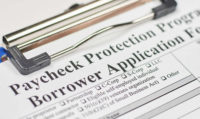Call it PPP federal rescue loans, Version 2.
For design and construction firms still struggling with the economic uncertainties brought on by the COVID-19 pandemic, the rules of the federal Paycheck Protection Program will be clearer in its revision.
The loans are covered by a federal year-end legislative package that provides funding for a $284.6-billion second draw.
After Congress pushed through the initial $659-billion forgivable loan program in April with limited details, many construction companies grew frustrated as the guidance trolled out over the following months, including some onerous provisions, says Jimmy Christianson, vice president of government relations at Associated General Contractors of America.
But after nearly eight months of working through the program, he says the new effort will offer a lot more clarity about the application process.
“There's a lot less of a guessing game this time, a lot less worries that someone could play gotcha.”
– Jimmy Christianson, Associated General Contractors of America
“There’s a lot less of a guessing game this time, a lot less worries that someone could play gotcha,” he says.
Last month, AGC sued the U.S. Small Business Administration over its changing the rules governing the loans in the first draw. Construction-related companies were the most numerous borrowers in the first round.
One major issue resolved is that the program now allows full deductibility of business expenses paid for with forgiven PPP loan funds, which Christianson says overturns the previous U.S. Internal Revenue Service position on such expenses. AGC estimates that the previous IRS guidance represented up to a 37% tax increase for some borrowers.
Expense categories for PPP loan forgiveness eligibility were also expanded, including worker protection expenditures related to the pandemic, such as personal protection equipment. Expenditures related to remote work, such as software and cloud services, are also covered. Christianson notes that these modifications are retroactive, applying to the first draw as well.
With more clarity, however, applicants also face more stringent eligibility requirements than under the first program. Companies will need to show that they logged a 25% drop in gross revenue receipts in any quarter of 2020, compared to the same quarter in 2019.
William S. Durr, attorney at Ward and Smith, notes that the loan amount may be up to 2.5 times the average monthly payroll costs in one year prior to loan application or the calendar year. There will also be a continuation of the previous 60/40 allocation between payroll and non-payroll costs in order to receive full forgiveness.
The revised PPP also slashes the size of companies allowed to participate to those with 300 or fewer employees.—down from a limit of 500. Total loan amount is also capped at $2 million, down from $5 million previously.
Additionally, companies seeking loans of less than $150,000 must fill out a simplified one-page loan forgiveness certification form. The revised program specifically sets aside $25 billion for borrowers with 10 or fewer employees.
Significant PPP Loan Changes Made
Jack Callahan, a partner in accountant CohnReznick’s construction practice, says the second draw marks a significant improvement for small business and those in underserved communities.
“It was always a big concern that the smaller contractors were being locked out of the program,” he says. “They couldn’t get into the banks’ queues.," He adds that many lacked staff for the approval process, compared to larger companies used to filling out government agency forms that could get it done quickly.
Barry Fischman, tax leader in accounting firm Marcum’s national construction group, also notes that public companies are ineligible as well as some firms that have more than 20% foreign ownership.
“We’ve seen quite a bit of foreign contractors looking to get feet on the ground in the U.S.,” he says, noting that the program specifically calls out investment from China. “Those companies could get kicked out of the program.”
Although the revised PPP offers a smaller pool of funds, Christianson says he expects participation among construction firms to be more limited.
“It’s a different time period and a different state of mind now,” he says. “No one knew what the future would be back in April when this program first came out. No one knew if a business would be operating. We didn’t have a vaccine. It was a very different time.”
Still, Jim Hazel, shareholder at accounting firm Elliott Davis, expects many contractors that were hesitant to apply for the first round may now decide to participate in the second. “Some were hesitant to take the funds because they didn’t know what to expect,” he adds. “Now they have a little more hindsight. There’s a better sense of what we’re experiencing and what the implications are down the road. So maybe now they can justify the application for the loan.”
Durr notes that some firms returned all or part of their initial PPP loans, but those firms will be allowed to reapply.
“Do not let this opportunity pass you by,” he says. “Take the time to reconsider, review and re-analyze your eligibility in the context of current SBA rules and guidance.”
Although many lingering questions have been answered in the revised program, Durr says Congress tasked SBA with providing more detailed guidance.
“I am hopeful that the SBA will draft new and additional rules and guidance with a heightened level of thought and precision, to reduce the struggles and frustration our clients experienced with the first round's rules and guidance.”
Lawsuit Over Forgiveness Rules
AGC saw some progress in its argument with SBA over rules almost immediately after filing its lawsuit against the agency and the U.S. Office of Management and Budget in U.S. District Court for the District of Columbia, on Dec. 8.
AGC was seeking to prompt a language change in the questionnaire used to evaluate if applicants are eligible to have PPP loans forgiven; one day later, SBA issued added guidance related to the document.
The agency said on Dec. 9 that in reviewing a company's good-faith certification that "economic uncertainty" made the PPP loan necessary to support the borrower's "continuing operations," it would look at the applicant's "individual circumstances."
[View SBA Dec. 9 guidance here. See p. 19, Question and Answer #53.]
AGC's lawsuit contends that the group “is challenging the legality of the questionnaire and the legal adequacy of the process undertaken by both SBA and OMB in developing, approving and publishing the questionnaire for use.”
The group says that the filing deals with “the manner by which SBA is now making its forgiveness determinations and even second-guessing borrower eligibility for PPP loans in the first place.”
Brian Turmail, an AGC spokesperson, said in an email to ENR that the association was "encouraged" by SBA's new guidance. But he added that "our litigation remains active" while it seeks "additional clarifications and guarantees" that the agency would base its reviews of the forgiveness applications "on the conditions at the time of the loan application, and not after ..."




Post a comment to this article
Report Abusive Comment